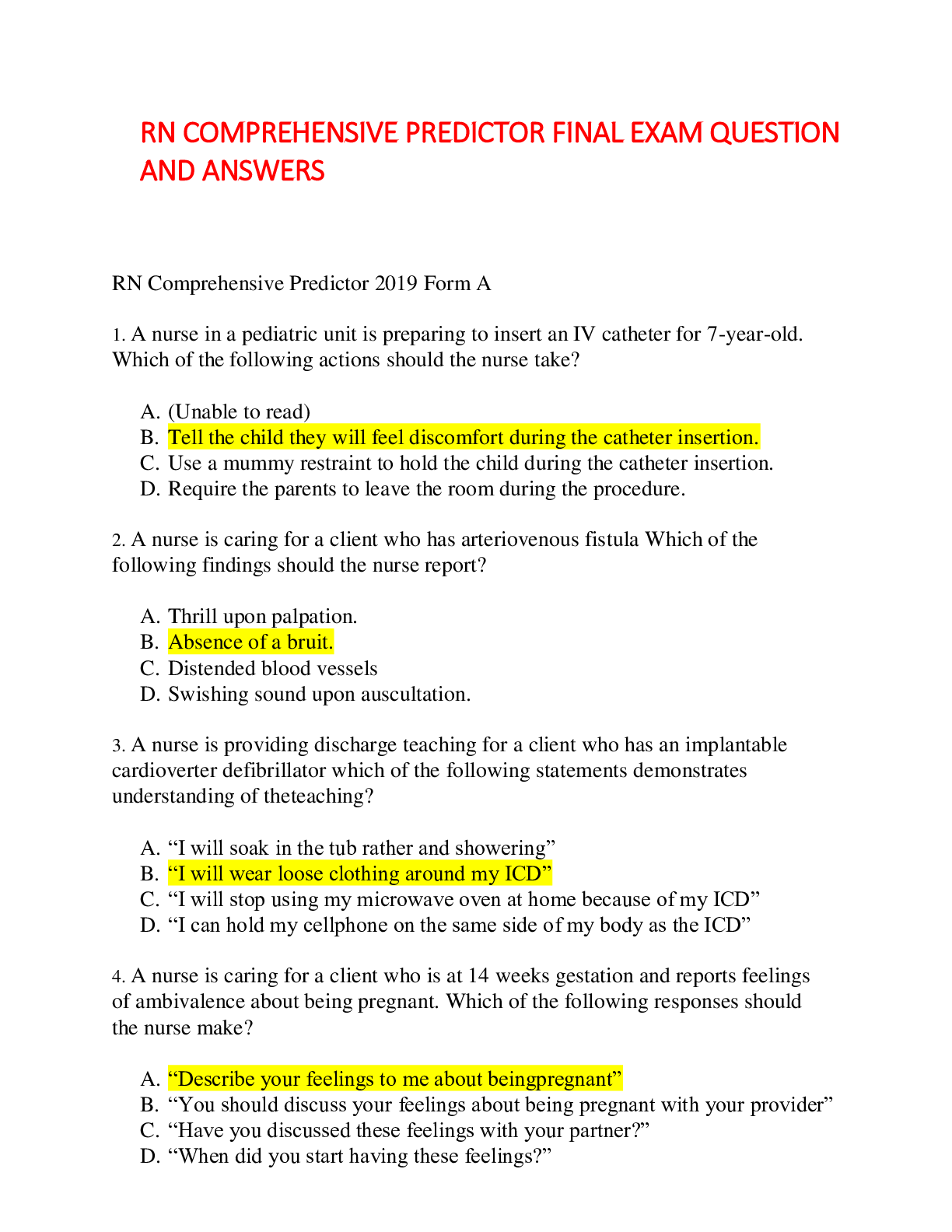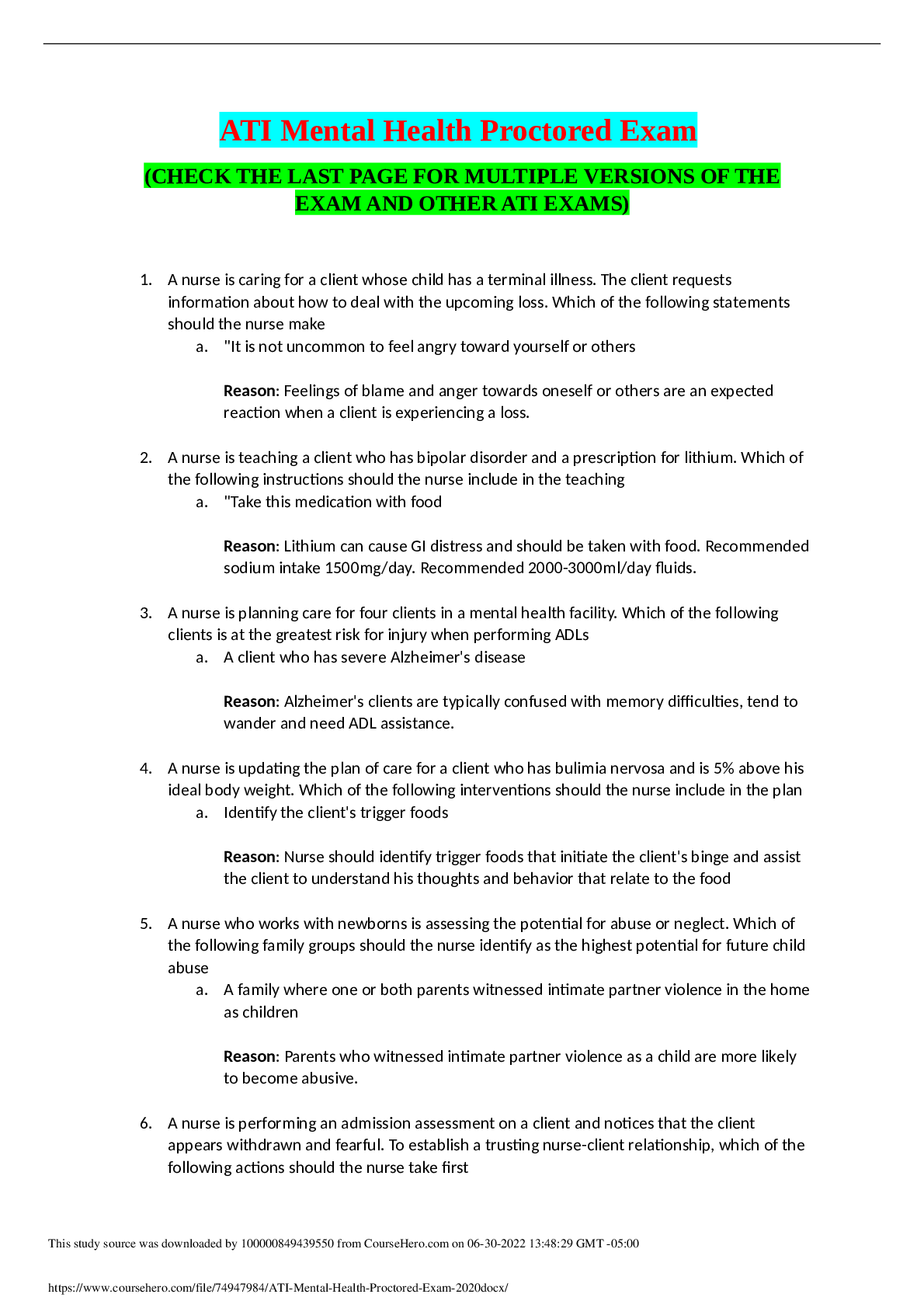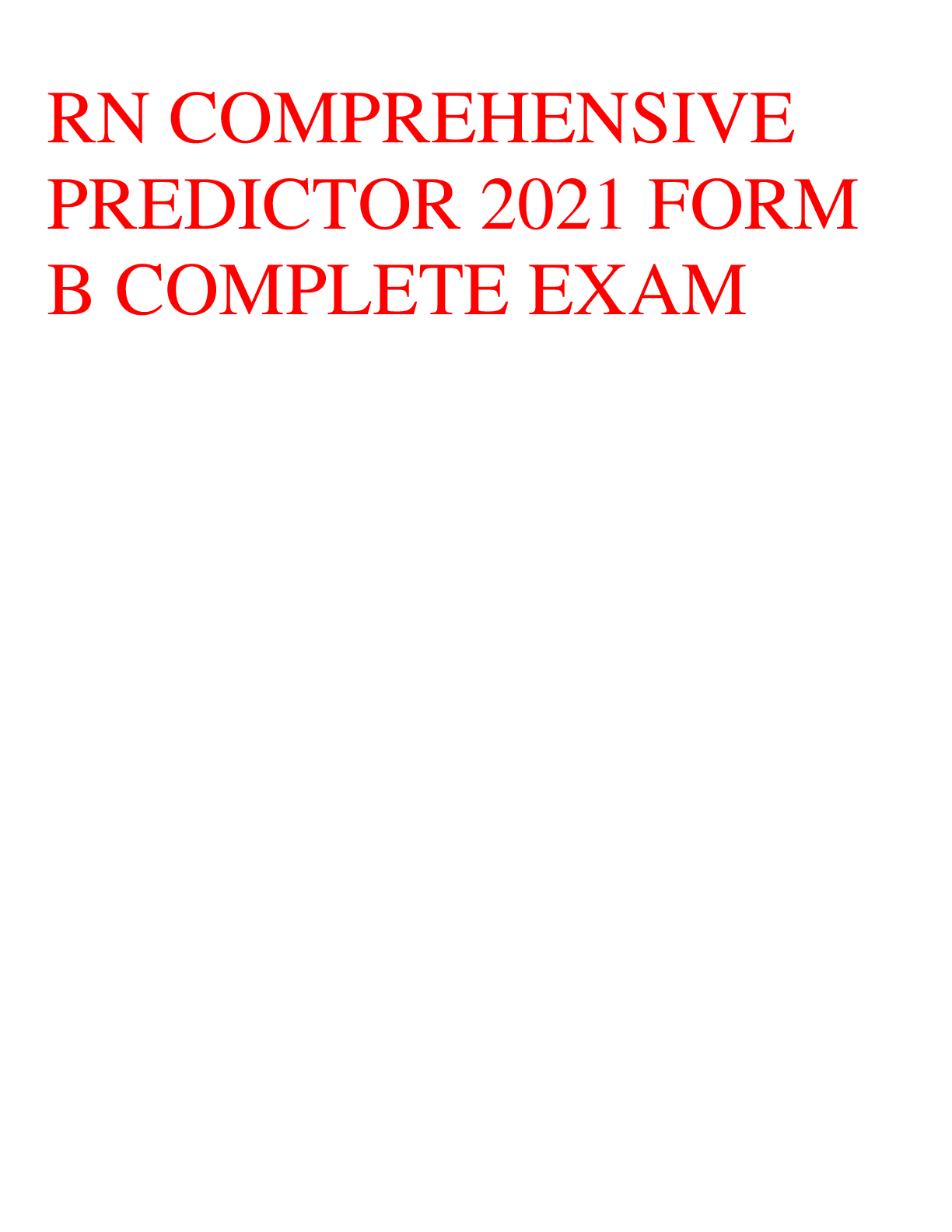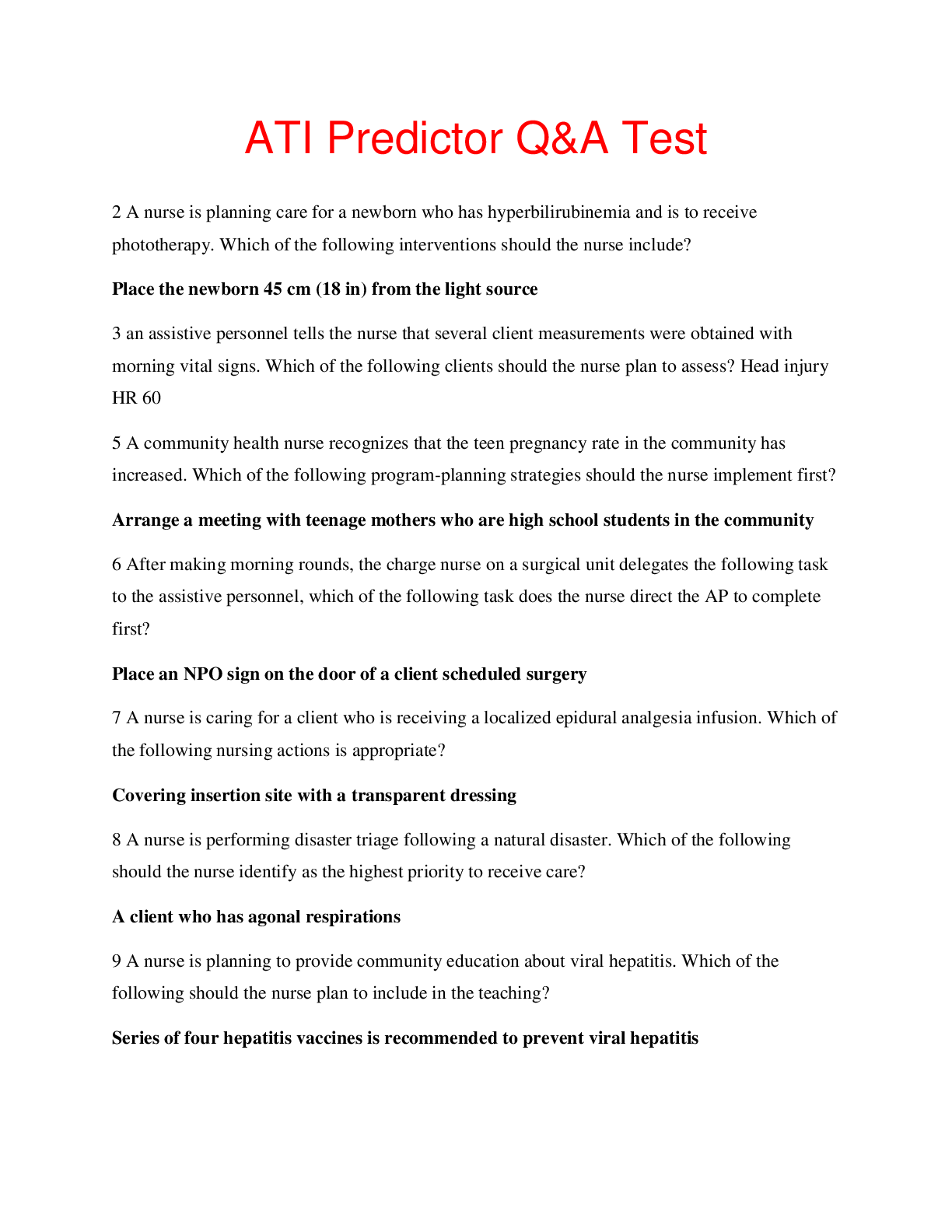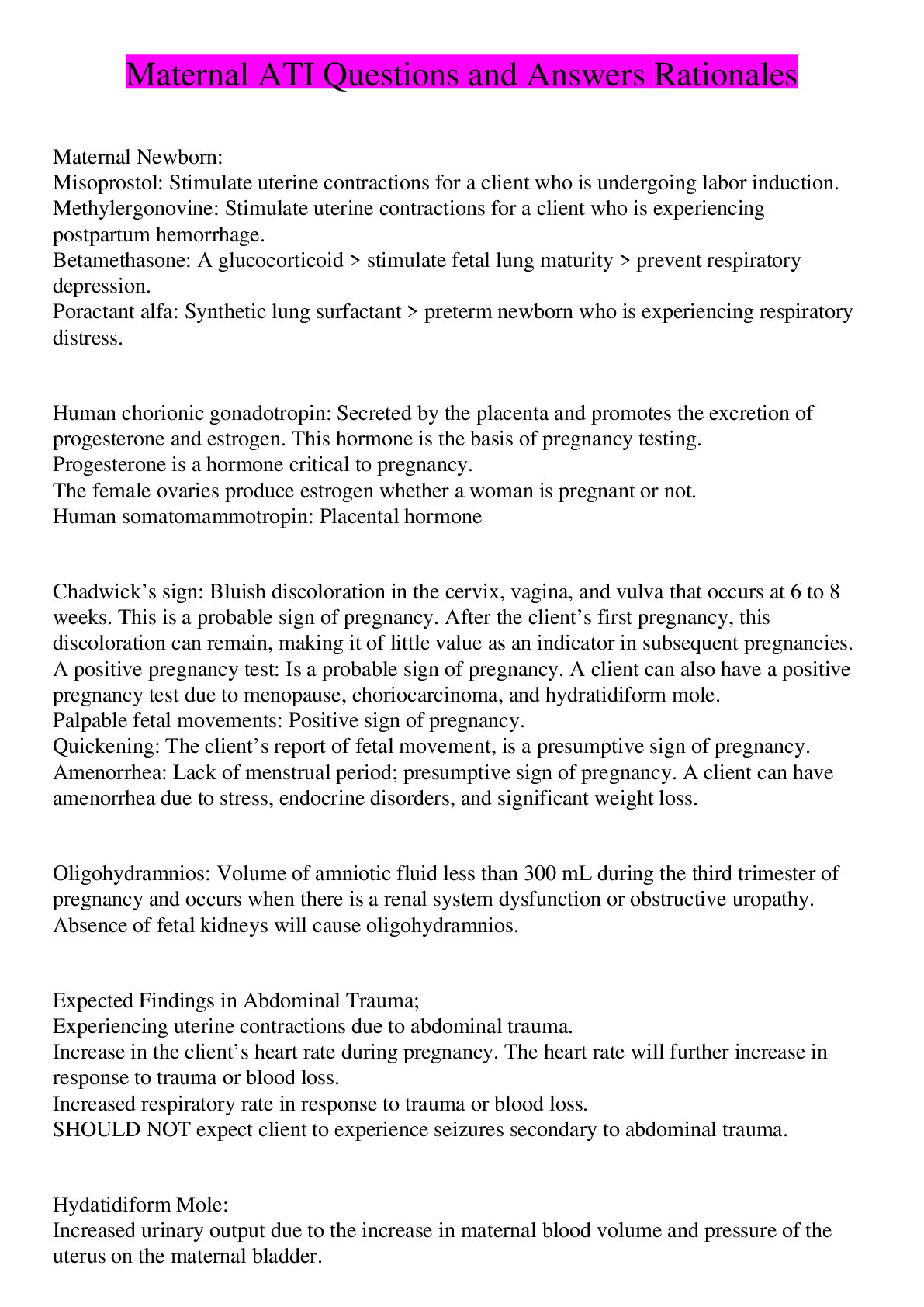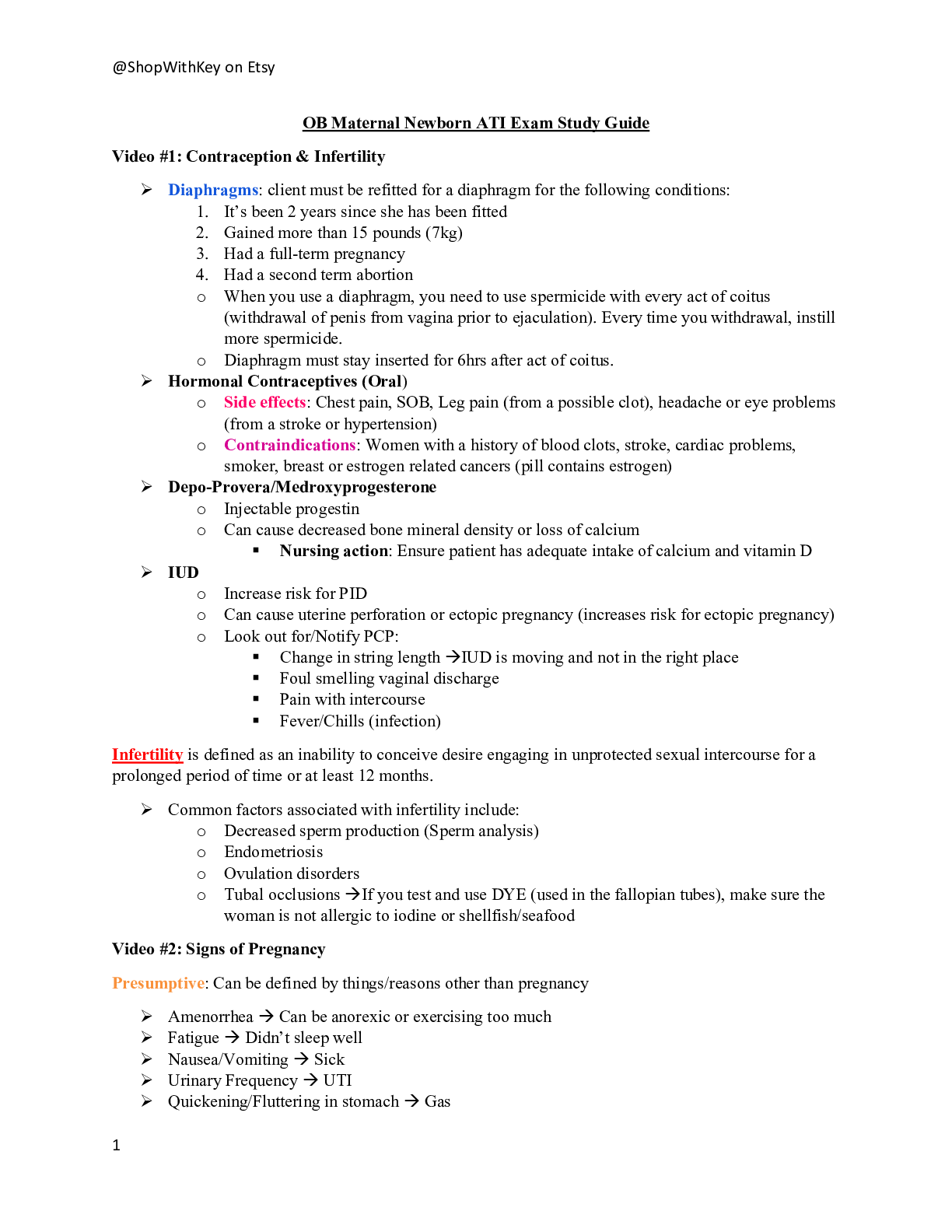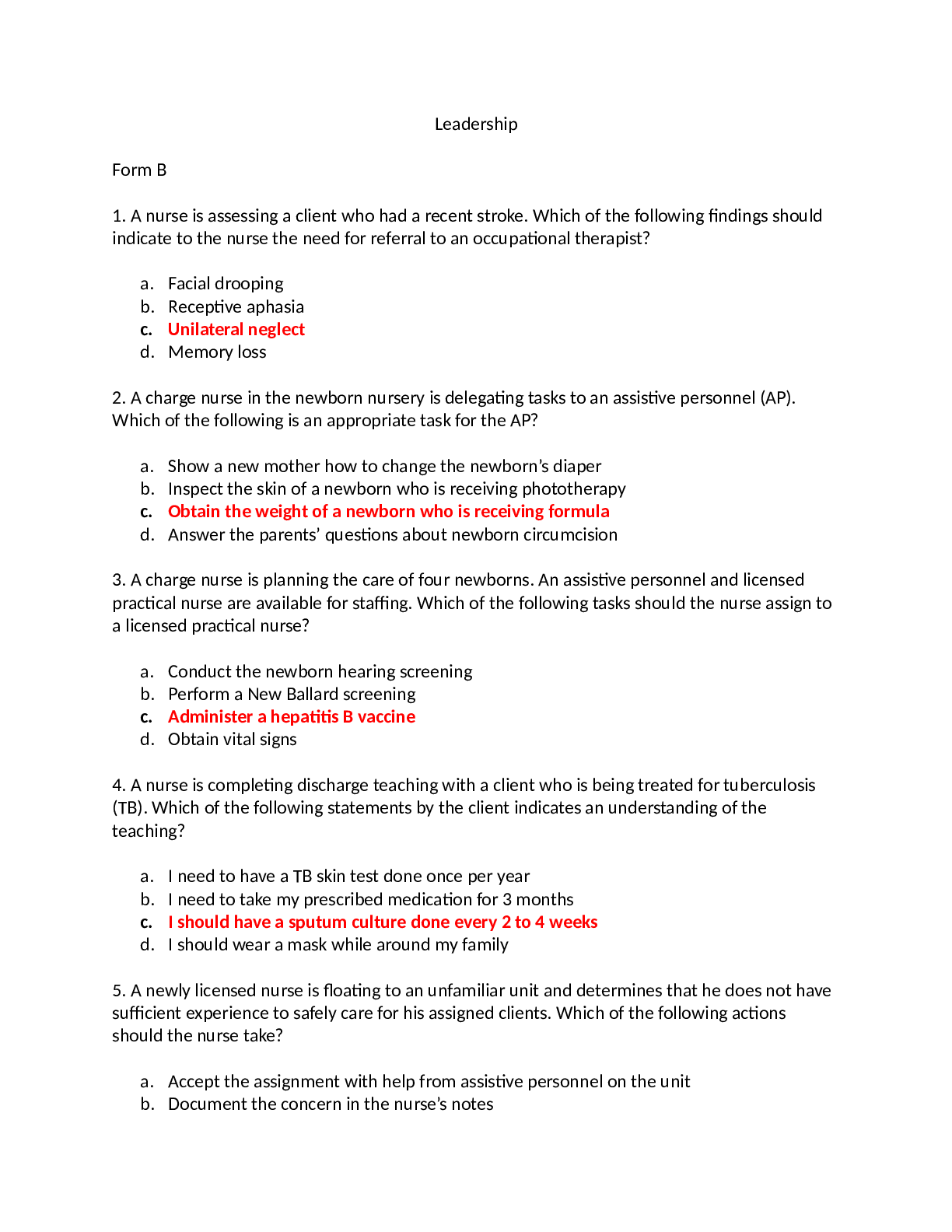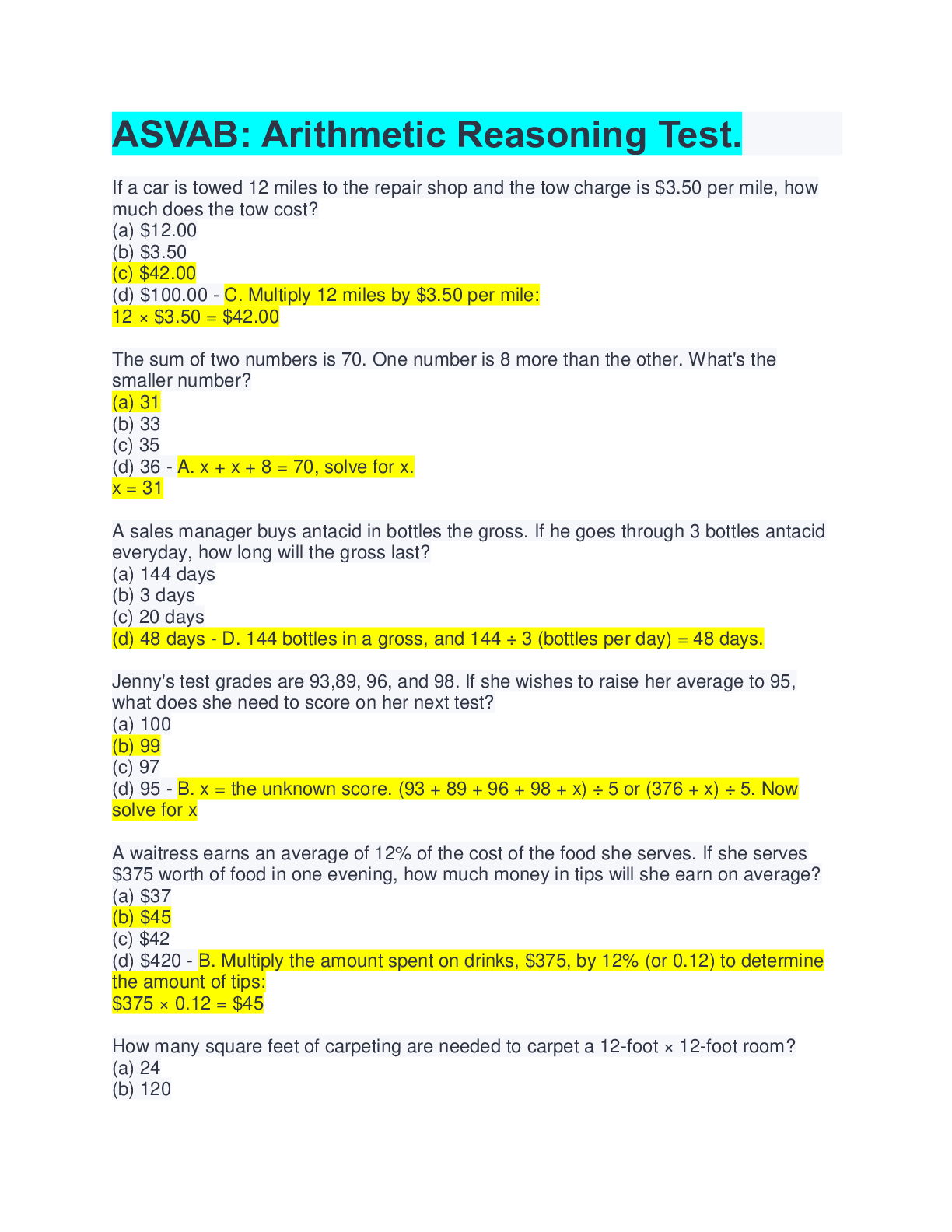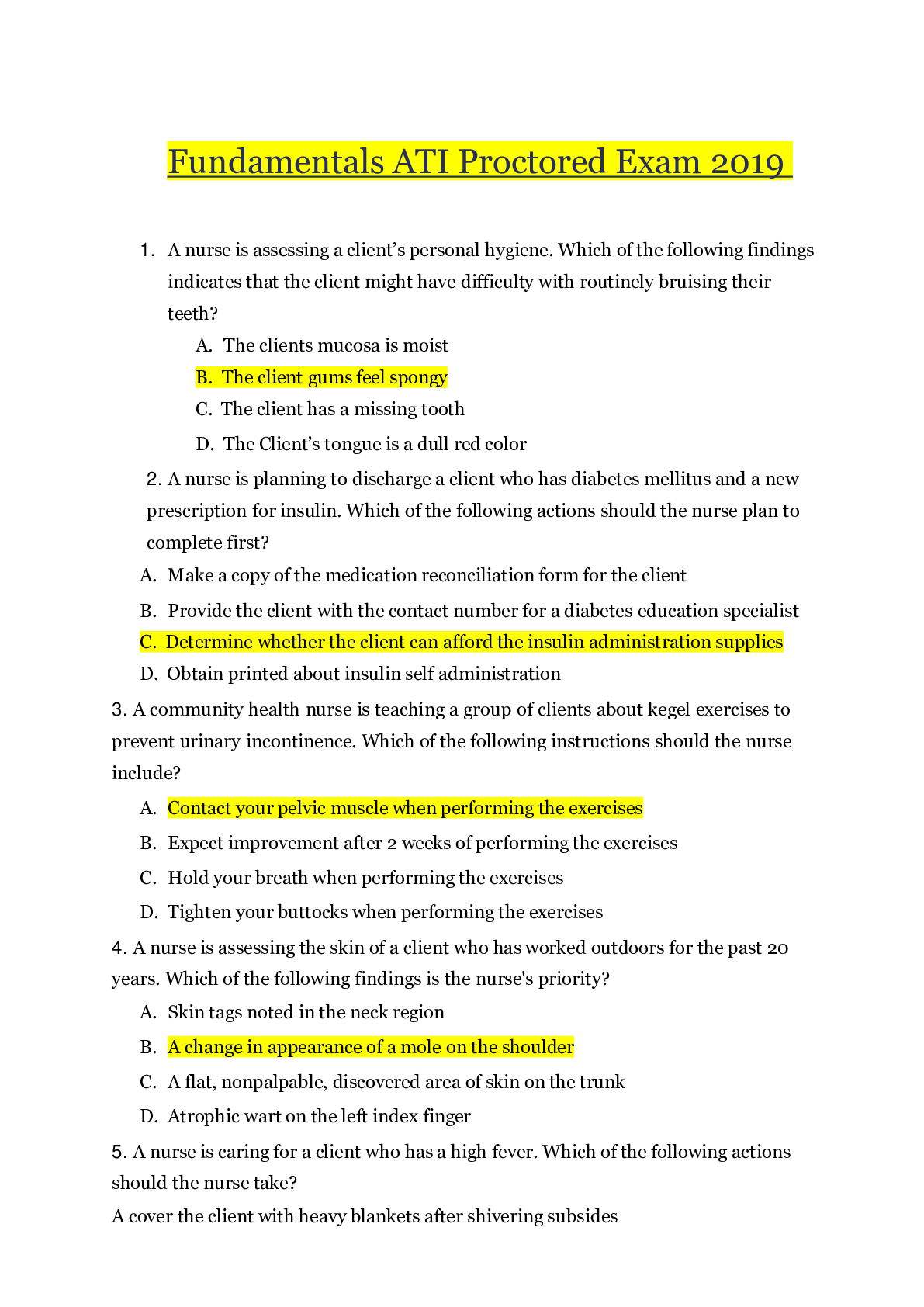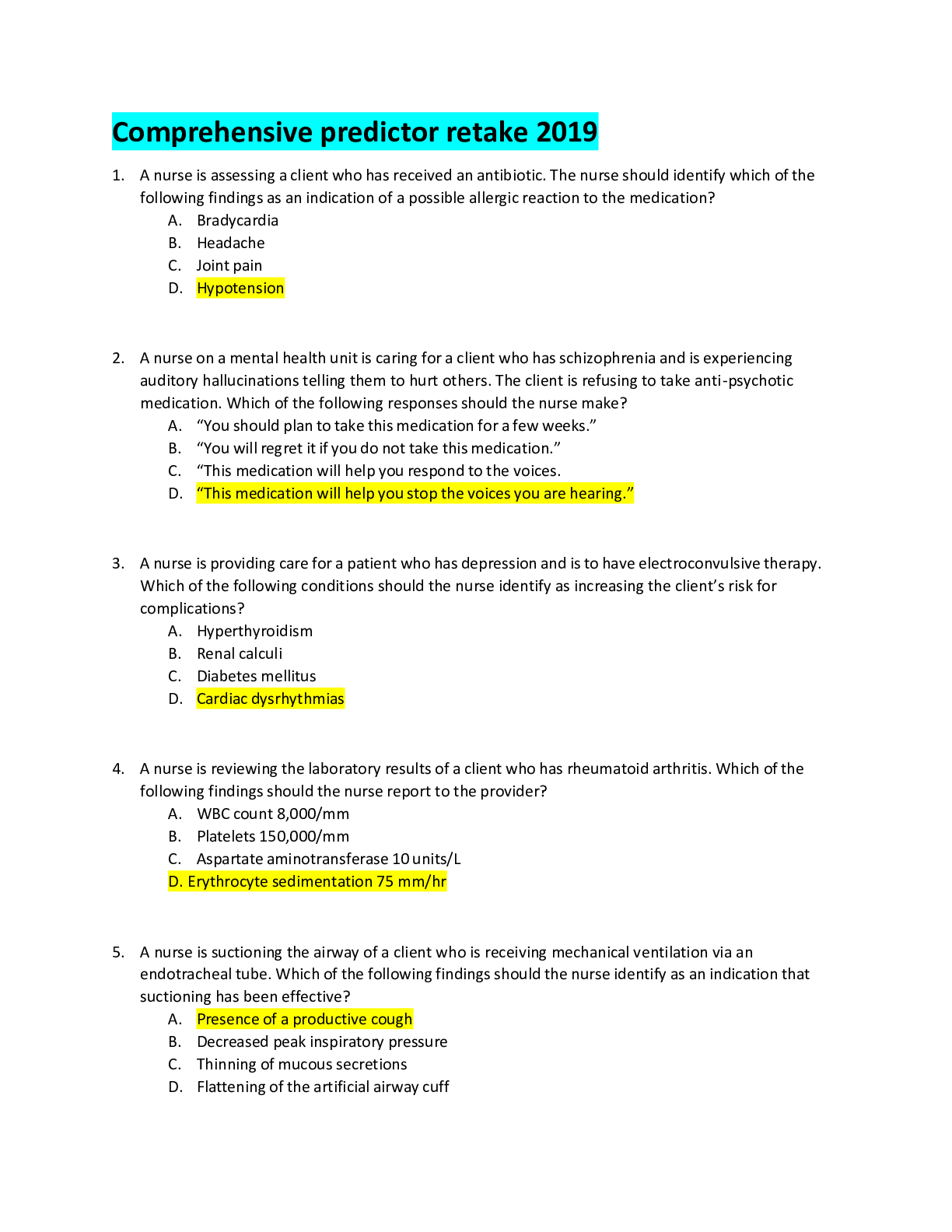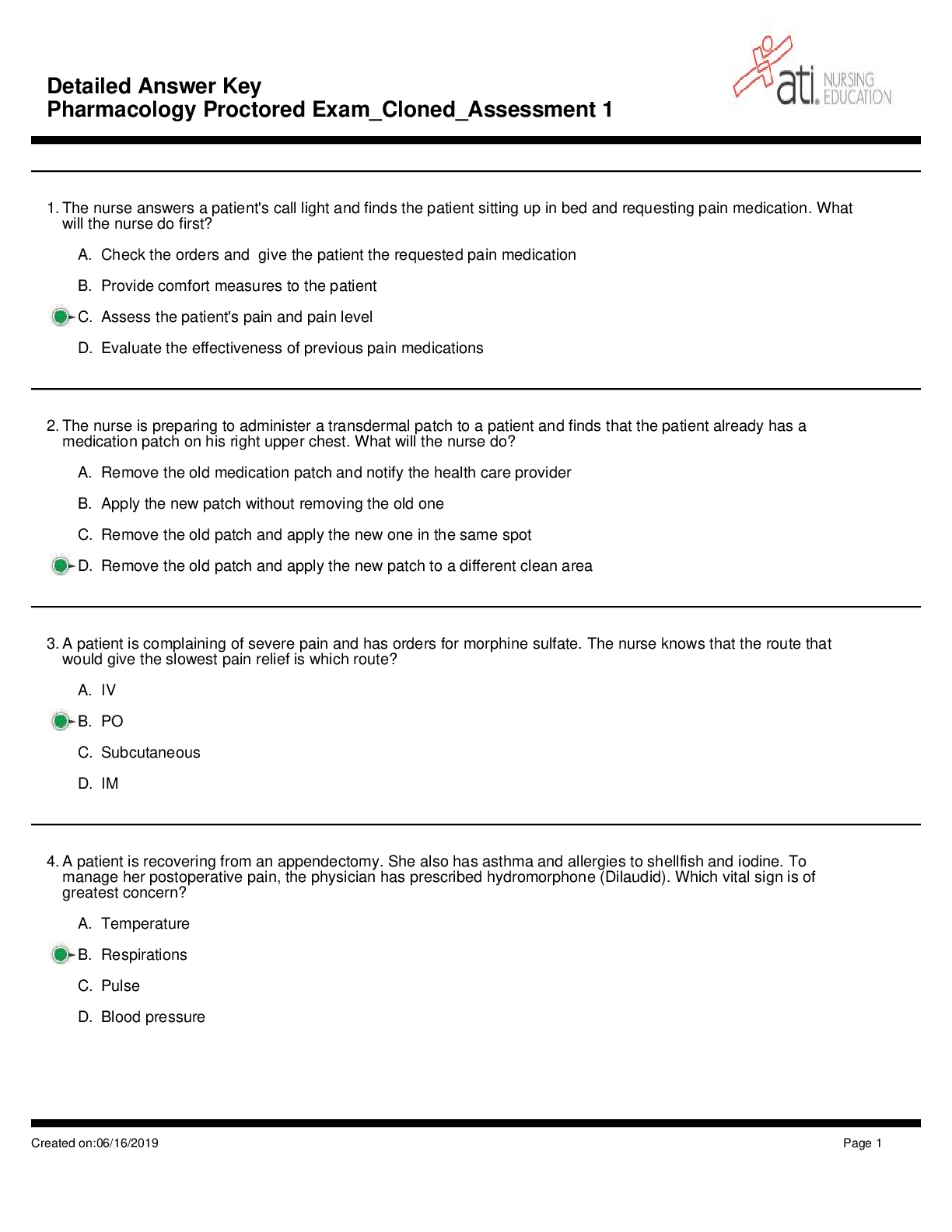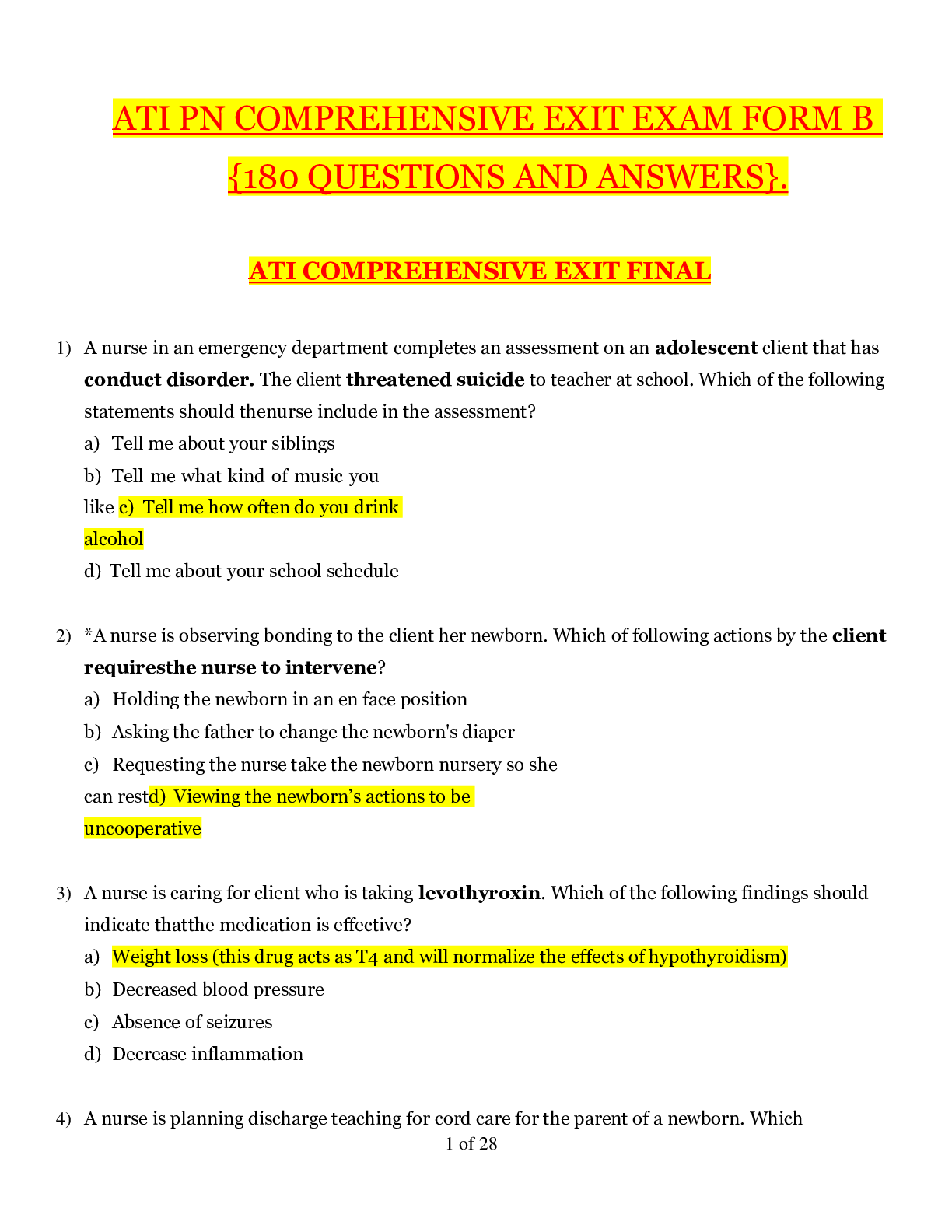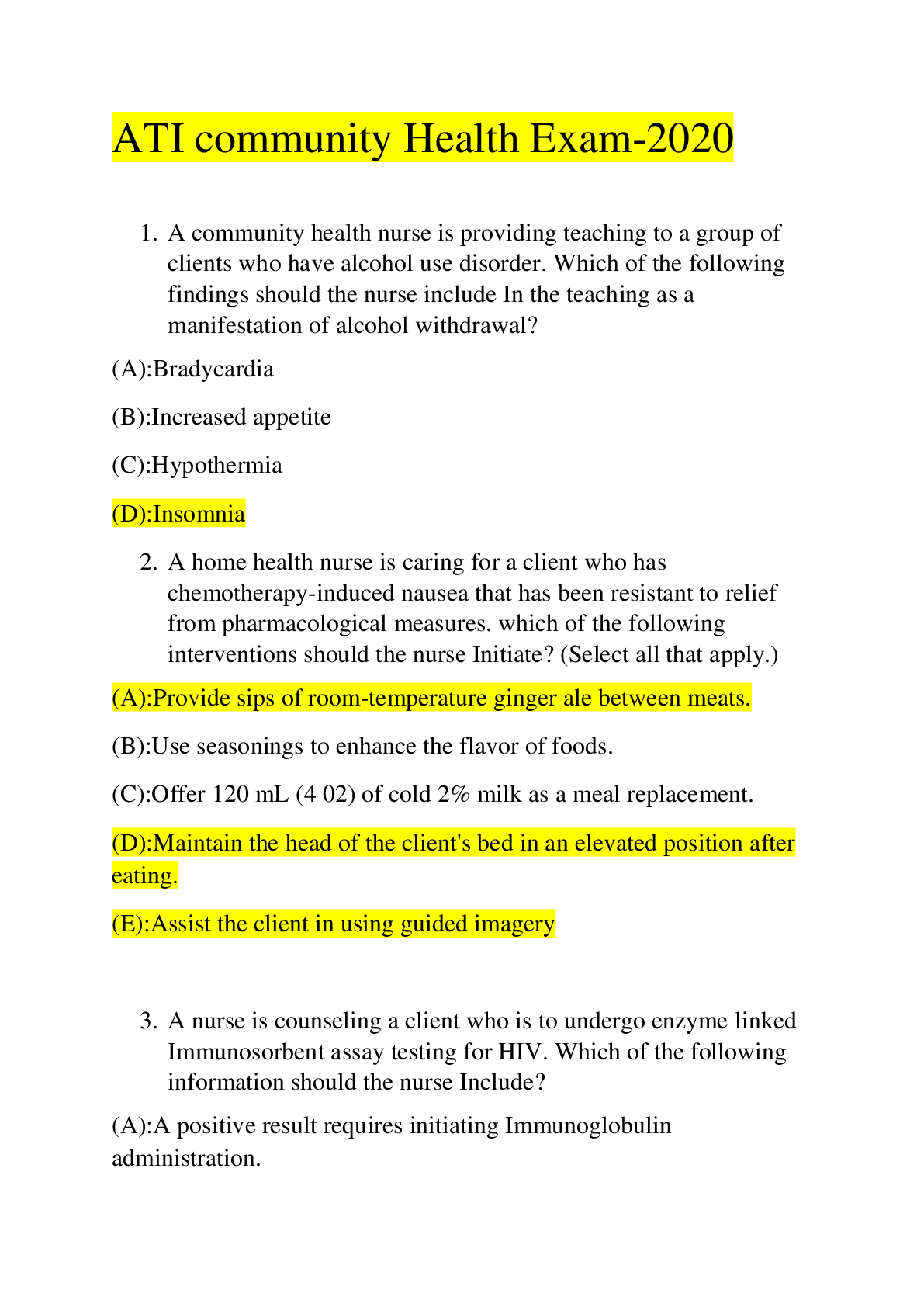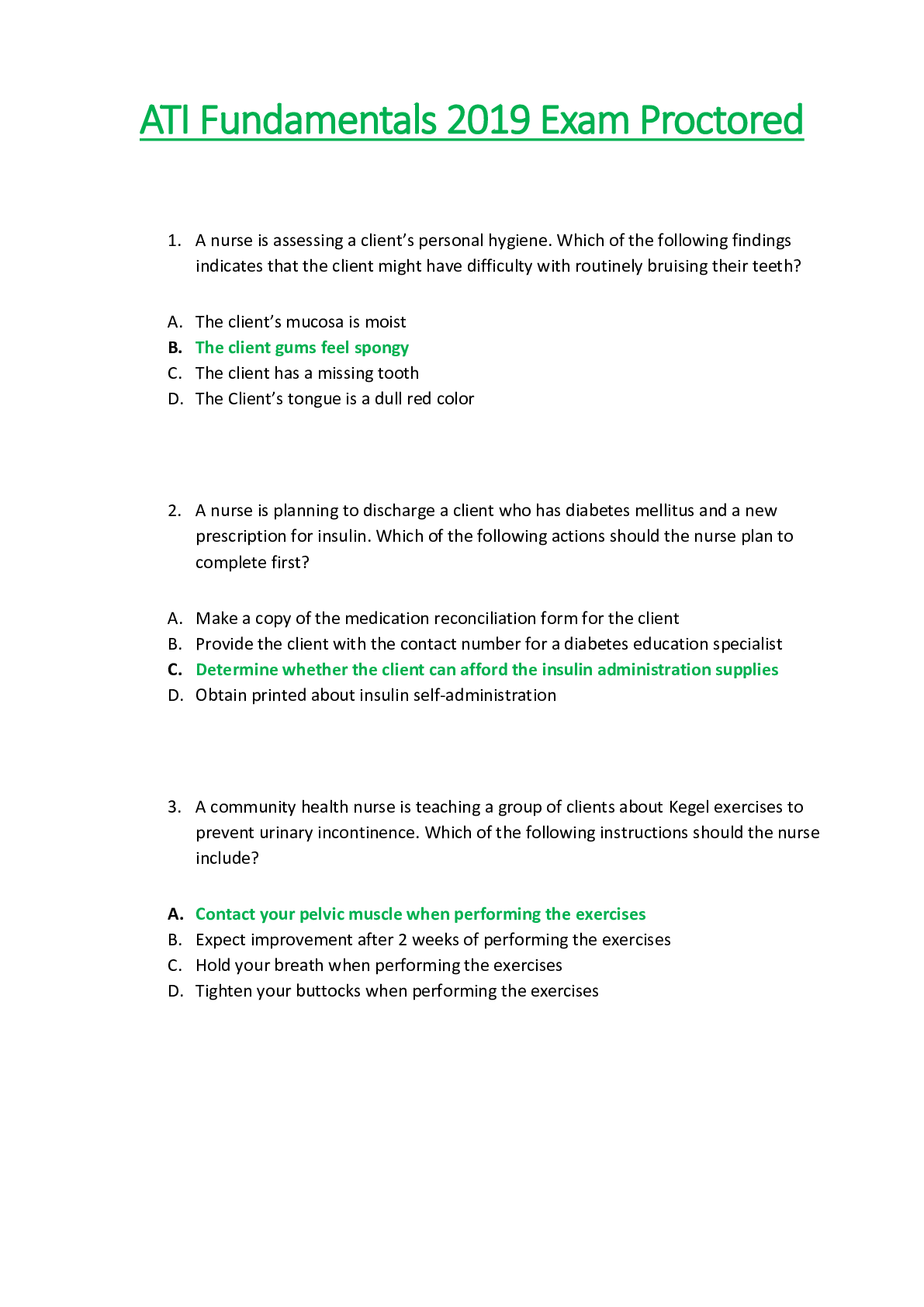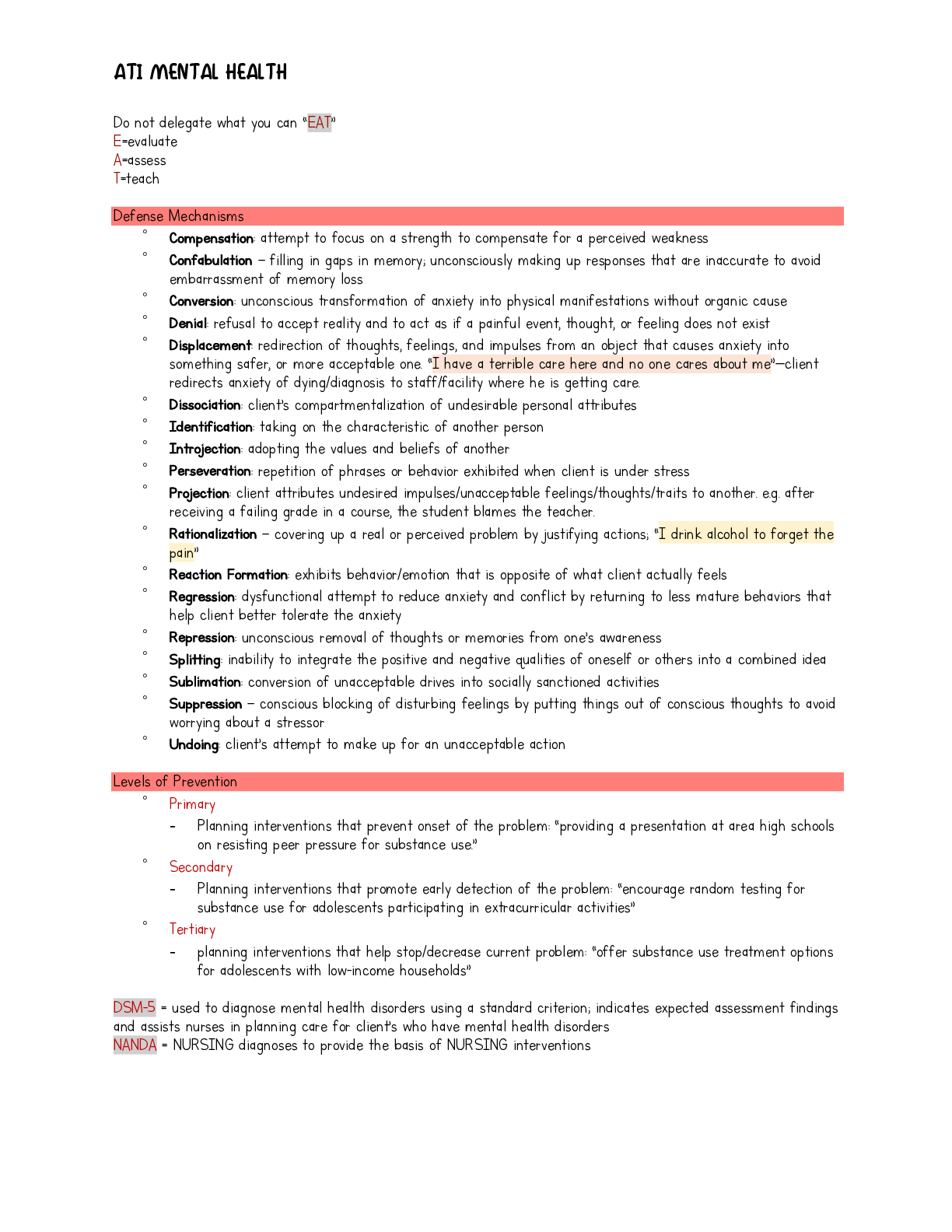*NURSING > EXAM PROCTORED > ATI MATERNAL-NEWBORN QUESTIONS AND ANSWERS_LATEST,100% CORRECT (All)
ATI MATERNAL-NEWBORN QUESTIONS AND ANSWERS_LATEST,100% CORRECT
Document Content and Description Below
ATI MATERNAL-NEWBORN QUESTIONS AND ANSWERS_LATEST 1. Two days after delivery, a postpartum client prepares for discharge. What should the nurse teach her about lochia flow? The color of the lochi... a changes from a bright red to white after four days Numerous large clots are normal for the next three to four days Saturation of the perineal pad with blood is expected when getting up from the bed Lochia should last for about 3 weeks, changing color every few days 2. A nurse monitors fetal well-being by means of an external monitor. At the peak of the contractions, the fetal heart rate has repeatedly dropped 30 beats/min below the baseline. Late decelerations are suspected and the nurse notifies the physician. Which is the rationale for this action? . The umbilical cord is wrapped tightly around the fetus' neck The fetal cord is being compressed due to rapid descent of the fetal head Maternal contractions are not adequate enough to deliver the fetus The fetus is not receiving adequate oxygen and is in distress 3. Which preoperative nursing interventions should be included for a client who is scheduled to have an emergency cesarean birth? Monitor oxygen saturation and administer pain medication. Assess vital signs every 15 minutes and instruct the client about postoperative care. Alleviate anxiety and insert an indwelling catheter. Perform a sterile vaginal examination and assess breath sounds. 4. Which nursing instruction should be given to the breastfeeding mother regarding care of the breasts after discharge? The baby should be given a bottle of formula if engorgement occurs. The nipples should be covered with lotion when the baby is not nursing. The breasts should be pumped if the baby is not sucking adequately. The breasts should be washed with soap and water once per day. 5. A client in preterm labor is admitted to the hospital. Which classification of drugs should the nurse anticipate administering? Tocolytics Anticonvulsants Glucocorticoids Anti-infective 6. Which of the following are probable signs, strongly indicating pregnancy? Presence of fetal heart sounds and quickening Missed menstrual periods, nausea, and vomiting Hegar's sign, Chadwick's sign, and ballottement Increased urination and tenderness of the breasts 7. Two hours after delivery the nurse assesses the client and documents that the fundus is soft, boggy, above the level of the umbilicus, and displaced to the right side. The nurse encourages the client to void. Which is the rationale for this nursing action? A full bladder prevents normal contractions of the uterus. An overdistended bladder may press against the episiotomy causing dehiscence. Distention of the bladder can cause urinary stasis and infection. It makes the client more comfortable when the fundus is massaged. 8. Which site is preferred for giving an IM injection to a newborn? Ventrogluteal Vastus lateralis Rectus femoris Dorsogluteal 9. During the first twelve hours following a normal vaginal delivery, the client voids 2,000 mL of urine. How should the nurse interpret this finding? High output renal failure Normal diuresis after delivery 10. If a pregnant client diagnosed with gestational diabetes cannot maintain control of her blood sugar by diet alone, which medication will she receive? Metformin (Glucophage) Glucagon Insulin 11. Which assessment finding indicates that placental separation has occurred during the third stage of labor? Decreased vaginal bleeding Contractions stop Maternal shaking and chills Lengthening of the umbilical cord 12. The nurse midwife is concerned about a pregnant client who is suspected of having a TORCH infection. Which is the main reason TORCH infections are grouped together? They are: benign to the woman but cause death to the fetus. sexually transmitted. capable of infecting the fetus. transmitted to the pregnant woman by a vector. 13. During the postpartum period, a hospitalized client complains of discomfort related to her episiotomy. The nurse assigns the diagnosis of “pain related to perineal sutures.” Which nursing intervention is most appropriate during the first 24 hours following an episiotomy? Instruct the client to use petroleum jelly on the episiotomy after voiding. Encourage the client to practice Kegel exercises. Advise the client to take a warm sitz bath every four hours. Apply ice packs to the perineum. 14. A client asks the nurse about the benefits of breastfeeding. Which response by the nurse provides the most accurate information? Breastfeeding helps women lose weight faster. Breast milk is easier to digest than formula. Breastfeeding is a good method of contraception. 15. Which physiological change takes place during the puerperium? The endometrium begins to undergo alterations necessary for menstruation. The placenta begins to separate from the uterine wall. The uterus returns to a pre-pregnant size and location. 16. A client delivered two days ago and is suspected of having postpartum "blues." Which symptoms confirm the diagnosis? Uncontrollable crying and insecurity Depression and suicidal thoughts Sense of the inability to care for the family and extreme anxiety Nausea and vomiting 17. Shortly after delivery, the nursery nurse gives the newborn an injection of phytonadione (Vitamin K). The infant's grandmother wants to know why the baby got “a shot in his leg.” Which response by the nurse is most appropriate? "Vitamin K promotes bone and muscle growth." "Vitamin K helps the baby digest milk." "Vitamin K helps stabilize the baby's blood sugar." "Vitamin K is used to prevent bleeding." 18. At 10 weeks gestation, a primigravida asks the nurse what is occurring developmentally with her baby. Which response by the nurse is correct? "The skin is wrinkled and fat is being formed." "The eyelids are open and he can see." "The kidneys are making urine." 19. A nurse in the clinic instructs a primigravida about the danger signs of pregnancy. The client demonstrates understanding of the instructions, stating she will notify the physician if which sign occurs? Abdominal pain 20. An hour after delivery, the nurse instills erythromycin (Ilotycin) ointment into the eyes of a newborn. The main objective of the treatment is to prevent infection caused by which organism? Gonorrhea 21. A woman in active labor receives a narcotic analgesic for pain control. If the narcotic is given a half an hour before delivery, which effect will the medication have on the infant? It will cause the infant's: blood sugar to fall. respiratory rate to decrease. heart rate to increase. movements to be hyperactive. 22. For a client in the second trimester of pregnancy, which assessment data support a diagnosis of pregnancy-induced hypertension (PIH)? Hemoglobin 10.2 mg/dL and uterine tenderness Polyuria and weight loss of 3 pounds in the last month Blood pressure 168/110 and 3+ proteinuria Hematuria and blood glucose of 160 mg/dL 23. A 35-week gestation infant was delivered by forceps. Which assessment findings should alert the nurse to a possible complication of the forceps delivery? Weak, ineffective suck, and scalp edema Molding of the head and jitteriness Shrill, high pitched cry, and tachypnea Hypothermia and hemoglobin of 12.5 g/dL 24. In which position should the nurse place the laboring client in order to increase the intensity of the contractions and improve oxygenation to the fetus? Left side-lying High Fowler's 25. A woman enters the birthing center in active labor. She tells the nurse that her membranes ruptured 26 hours ago. The nurse immediately takes the client's vital signs. Which is the rationale for the nurse's actions? Pulse rates rise the longer the membranes are ruptured Respiratory rates decrease due to lack of fluid in the uterus Prolonged rupture of membranes can lead to transient hypertension Infection is a complication of prolonged rupture of membranes 26. A new client's pregnancy is confirmed at 10 weeks gestation. Her history reveals that her first two pregnancies ended in spontaneous abortion at 12 and 20 weeks. She has a4-year-old and a set of 1-year-old twins. How should the nurse record the client's current gravida and para status? Gravida 2, para 3 Gravida 4, para 2 Gravida 5, para 2 Gravida 5, para 4 27. A 16-year-old client reports to the school nurse because of nausea and vomiting. After exploring the signs and symptoms with the client, the nurse asks the girl whether she could be pregnant. The girl confirms that she is pregnant, but states that she does not know how it happened. Which nursing diagnosis is most important? Knowledge deficit related to the client's developmental stage and age 28. A client is admitted to the hospital for induction of labor. Which are the main indications for labor induction? Placenta previa and twins Pregnancy-induced hypertension and postterm fetus Breech position and prematurity Cephalopelvic disproportion and fetal distress 29. A client in active labor receives a regional anesthetic. Which is the main purpose of regional anesthetics? To relieve pain by decreasing the client's level of consciousness To provide general loss of sensation by blocking sensory nerves to an area To provide pain relief by blocking descending impulses from the central nervous system To relieve pain by decreasing the perception of pain leading to the pain centers in the brain 30. The nursery nurse reviews a newborn's birth history and notes that the Apgar scores were 5 at one minute after birth, and 7 at five minutes after birth. How should the nurse interpret these scores? The infant: needed brief oral and nasal suctioning. required endotracheal intubation and bagging with a hand-held resuscitator. was stillborn and required CPR. required physical stimulation and supplemental oxygen. 31. With routine prenatal screening, a woman in the second trimester of pregnancy is confirmed to have gestational diabetes. How may the nurse explain the role of diet and insulin in the management of blood sugar during pregnancy? "Insulin lowers an elevated blood sugar during pregnancy to meet the increased metabolic needs of the baby." 32. A breastfeeding mother complains of cramping. Which is the main cause of the client's afterpains? Contractions of the uterus 33. A client who is 37 weeks gestation comes to the office for a routine visit. This is the client's first baby and she asks the nurse how she will know when labor begins. Which signs indicate that true labor has begun? Contractions that are irregular and decrease in intensity when walking Abdominal pain that starts at the fundus and progresses to the lower back Increased pressure on the bladder and urinary frequency Expulsion of pink-tinged mucous and contractions that start in the lower back 34. A multiparous woman with a history of all vaginal births is admitted to the hospital in labor. After several hours, the client's labor has not progressed and she is getting tired and restless. The decision is made to proceed with cesarean delivery. The nurse recognizes the client's knowledge deficit regarding the surgical delivery and care afterbirth. Which is the appropriate expected outcome for correction of the client's knowledge deficit? The client will: demonstrate appropriate coping mechanisms needed to get through the surgery. accept that the type of delivery will not affect the bonding with the baby. verbalize understanding about the reason for the unplanned surgery. demonstrate decreased anxiety and fear of the unknown. 35. The physician performs an amniotomy for a woman in labor. Which nursing action should follow the procedure? Assess the fluid for color, odor, and amount. 36. For a pregnant adolescent who is anemic, which foods should the nurse include In the client's dietary plan to increase iron levels? Milk and fish Orange juice and apricots Chicken and cottage cheese Pickles and peanut butter sandwiches 37. Which condition must occur in order for identical (monozygotic) twins to develop? One sperm fertilizes two ova Two sperm fertilize two ova One sperm fertilizes one ovum Two sperm fertilize one ovum 38. Which fetal structure is responsible for carrying oxygenated blood from the placenta to the fetus? Ductus arteriosus Umbilical artery Portal vein Umbilical vein 39. A client at 33 weeks gestation is admitted for suspected abruptio placenta. Which factor in the client's history supports this diagnosis? The client states that she: used crack an hour before the symptoms began. 40. Which explanation is most appropriate when describing physiological jaundice to the parents of a newborn? "The baby has a minor incompatibility of the blood." “The baby is breaking down the extra red blood cells that were present at birth.” “The baby is getting too much breast milk, but this is not dangerous.” “The baby may have gotten exposed to hepatitis B during the delivery.” 41. A woman at 42 weeks gestation enters the hospital for induction of labor. Since the infant is postterm, which complications should the nurse anticipate when planning for the delivery? Cephalopelvic disproportion and hypothermia Asphyxia and meconium aspiration Intraventricular hemorrhage and dry, cracked skin Hyperbilirubinemia and hypocalcemia 42. Which method of temperature regulation would safely and effectively prevent cold stress in a newly delivered infant? Wrap the baby loosely with a blanket. Be sure the baby's feet are covered. Cover the baby's head with a hat. Position the baby on a heating pad. 43. The nurse performs Leopold's maneuvers for a client admitted in labor. Which is the main goal of Leopold's maneuvers? To determine whether the client's cervix has dilated To assess the frequency and intensity of the contractions To assess whether membranes have been ruptured To determine the presentation and position of the fetus 44. Immediately after birth, the nurse places the newborn under a radiant warmer. Which is the primary rationale for the nurse's action? an efficient means of thermoregulation To facilitate initial assessment by the nurse To permit the use of the cardiac monitor To permit close observation by the family members 45. A client, gravida 1, para 0, in active labor, is becoming increasingly anxious. Which statement by the nurse will block therapeutic communication with the client? "What concerns are you having now?" "Tell me how you are feeling." "Everything is going just fine." "You seem a little nervous." 46. A nurse prepares to teach a class regarding postpartum care and includes infections in the teaching plan. Which is the main cause of mastitis in the postpartum client? Poor breast feeding technique 47. A postterm infant is delivered by cesarean section because of fetal distress and meconium-stained amniotic fluid. The nursery nurse frequently monitors the baby's respiratory rate, observing for tachypnea. Which is the reason for the nurse's actions? The infant may: experience respiratory depression from the medications used during delivery. develop meconium aspiration pneumonia. have an elevated temperature. have a pneumothorax related to delivery. 48. The nurse notices a variable deceleration on a fetal monitor strip. Which nursing action is appropriate? Instruct the mother to breathe slowly because this is a sign of hyperventilation. Decrease the amount of Pitocin because this is a sign of hypertonic uterine contractions. Turn the woman onto her left side to relieve pressure on the umbilical cord. Reduce the oral and IV fluids to decrease circulatory overload. 49. The nursery nurse delays the first bottle feeding of a newborn. Which is the most common reason for the nurse's actions? The infant has: a blood glucose of 45 gm/dL. a respiratory rate above 60. blue hands and feet. a heart murmur. 50. During active labor, after a sudden slowing of the fetal heart rate, the nurse assesses the woman's perineum and observes a prolapsed cord. Which nursing action is most appropriate? Hold the presenting part away from the cord. Insert a scalp electrode for an internal fetal monitor. Place the client in reverse Trendelenburg position. Cover the cord with a dry, sterile gauze. 51. A client is in the latent stage of labor. Which nursing intervention is most appropriate? Encourage the client to walk in the hall until membranes rupture. Instruct the client to place her head on her chest and push with the contraction. Teach the client to use the “pant-blow” method of breathing. 52. Which conditions create a risk for uterine atony in the immediate postpartum period? Multiparity and multiple gestation 53. A client at ten weeks gestation tells the nurse that she has been having “morning sickness.” The nurse advises the client to eat foods that are easy to digest and low in fat. Which is the rationale for the nurse's instruction? A low-fat diet increases peristalsis, which reduces the food volume in the stomach A low-fat diet is digested faster and leaves less in the stomach that can be vomited Easily digested foods provide a better balance of fluids and electrolytes, resulting in less nausea and vomiting Easily digested foods are less likely to cause relaxation of the cardiac sphincter, which causes regurgitation and vomiting 54. Which information is most important for the nurse to gather when a client is admitted to the unit in labor? Name of the support person Medical problems or complications Fluid preferences Amount of weight gained during the pregnancy 55. The nurse conducting a physical assessment notes that a 1-day-old newborn with dark skin has a bluish-gray discoloration over the lower back, the buttocks, and the scrotum. How should this assessment finding be documented? Mongolian spot 56. A small-for-gestational-age infant is irritable and jittery, and has hyperreflexia and clonus. He is jaundiced, has temperature instability, and spitty after feedings. The nurse suspects the infant is displaying signs of passive addiction during pregnancy. When planning for the infant's care at home, which nursing assessment is most important for the infant experiencing neonatal abstinence syndrome? The mother's ability to provide a safe environment The extent of addiction of the mother The mother's ability to obtain treatment The severity of the infant' s withdrawal 57. A woman in active labor is admitted to the labor and delivery unit, accompanied by her partner. As labor progresses, the nurse notes he is not interacting with the woman and sits in the corner, looking out the window. How may the nurse understand the man's actions? His actions reflect personality or cultural differences, which do not necessarily indicate a lack of concern. 58. A client is admitted to the hospital with severe pregnancy-induced hypertension (PIH). The physician orders magnesium sulfate. Which nursing intervention is important when administering this drug? Assess blood pressure and respiratory rate every fifteen minutes. Monitor blood glucose levels every eight hours. Evaluate for orthostatic hypotension when getting the client up to walk. Observe for premature labor every shift. 59. A 27-week gestation infant is taken to a newborn intensive care unit 150 miles away. Initially, which emotion should the nurse expect the mother to display after the transfer? Denial Frustration Guilt Anger 60. A 38 week gestation newborn weighs 4020 grams, is sluggish, and has limp muscle tone. The baby experienced a broken clavicle during delivery. Based on this information, which can the nurse conclude about the baby? Neonatal abstinence symptoms Large for gestational age Congenital cardiac defect Respiratory depression 61. Which assessment finding suggests thrombophlebitis in a postpartum client? Dyspnea, tachypnea, and apprehension Chills, hypotension, and abdominal tenderness Positive Homan's sign, calf warmth, and pain Dizziness, loss of consciousness, and chest pain 62. A client comes to the clinic to confirm that she is pregnant. Her last menstrual period was January 31st. According to Naegele's rule, when should the client expect to deliver? November 31 December 7 November 7 December 24 63. Which procedure should be avoided for the client known to have a placenta previa? A non-stress test A urinary catheterization A sterile vaginal exam An abdominal ultrasound 64. A woman in the first trimester comes to the clinic with vaginal bleeding. The physician determines that the fetus has died and that the placenta, fetus, and tissues still remain in the uterus. How should the findings be documented? Complete abortion Stillborn abortion Missed abortion Incomplete abortion 65. A woman in the transition stage of labor is using paced breathing to relieve pain. She complains of blurred vision, numbness, and tingling of her hands and mouth. Which condition is indicated by these signs and symptoms? Hyperventilation 66. Which data support a diagnosis of abruptio placenta in a pregnant woman? Uterine rigidity and abdominal pain 67. A women in her first trimester contracts rubella. How is the fetus likely to be affected? Reproductive and urinary defects Heart defects and cataracts Spinal cord and skeletal defects 68. An hour after delivery, a 4000 gram infant exhibits pallor, jitteriness, a blood sugar level of 40 gm/dL, irritability and periodic apnea. Which maternal condition could be the cause of the newborn's symptoms? Gestational diabetes 69. A client delivered vaginally six hours ago. Which assessment finding can be interpreted as normal? Temperature 100.0 degrees F 70. A new mother receives instructions about care of her newborn son's circumcision. Which statement made by the mother indicates that further teaching is needed? "I should wash off any yellowish mucous on my baby's penis." 71. A 17-year-old client delivered her first baby 8 hours ago. Which of the following is an indication that appropriate bonding is occurring? The client: makes eye contact with the baby. 72. A new mother is crying in her room. She tells the nurse that her new baby boy has enlarged breasts and she thinks that there is something wrong. How should the nurse respond? "Enlarged breasts are common for both boys and girls. It will go away." 73. During the active phase of labor, the membranes rupture and the nurse notes green amniotic fluid. Which nursing action should be initiated immediately? Assess fetal heart rate. 74. At 28 weeks gestation, a woman enters the hospital in preterm labor and receives atocolytic medication to stop labor. Which assessment findings should be reported immediately to the physician? Irregular contractions every 15-20 minutes that last 30 seconds before stopping 75. A labor and delivery nurse suspects that a client is in the transition stage of labor. Which information supports this conclusion? The client is: irritable and needs frequent repetition of directions. [Show More]
Last updated: 1 year ago
Preview 1 out of 12 pages

Reviews( 0 )
Document information
Connected school, study & course
About the document
Uploaded On
Mar 07, 2021
Number of pages
12
Written in
Additional information
This document has been written for:
Uploaded
Mar 07, 2021
Downloads
0
Views
76

